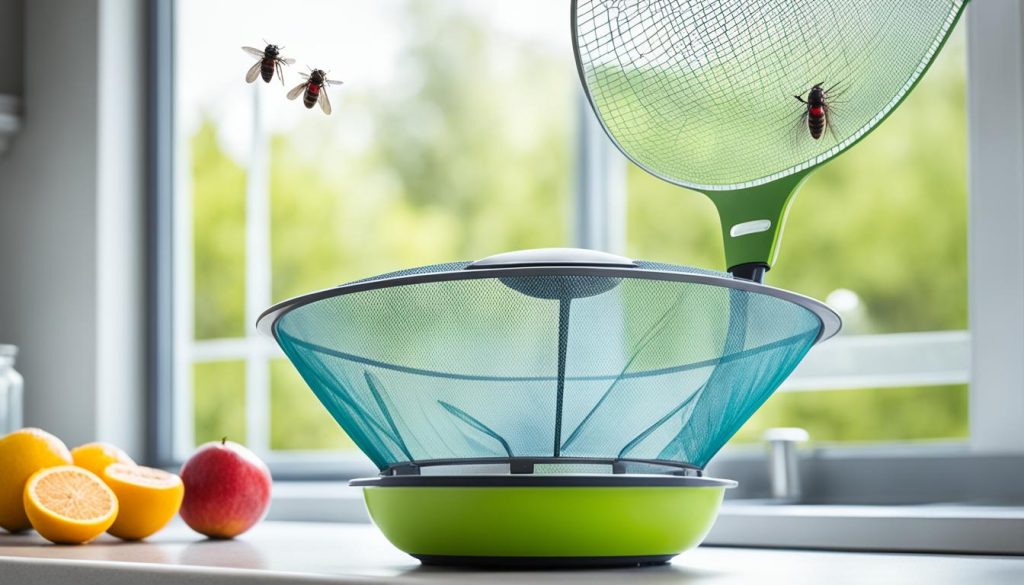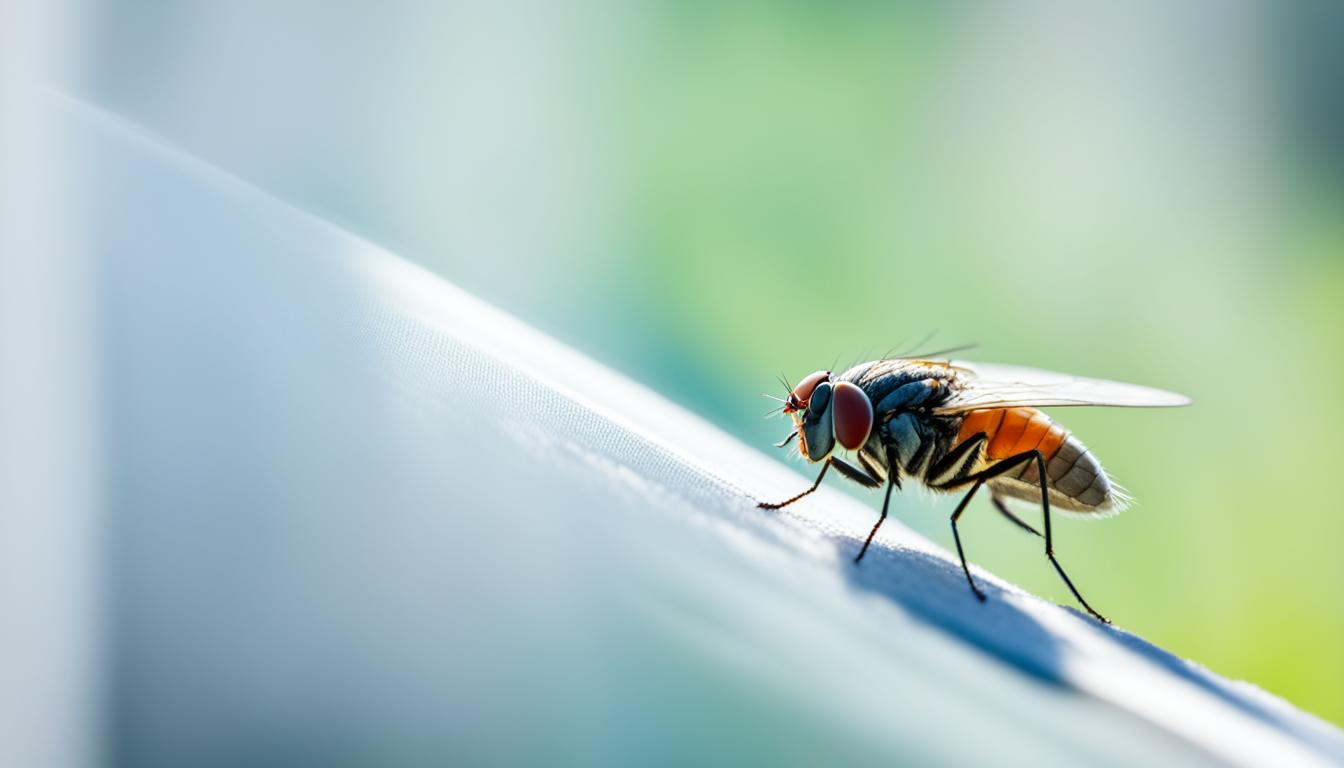Did you know that flies can enter a house through openings as small as 1/16th of an inch? That’s smaller than the diameter of a pencil lead! Flies are not only annoying pests but also carriers of diseases and pathogens, posing a risk to our health. Understanding how flies enter our homes and what attracts them is crucial in preventing fly infestations and maintaining a clean and healthy living environment.
Key Takeaways:
- Flies can enter a house through small openings in doors, windows, and walls.
- They are attracted to food, moisture, and decaying organic matter.
- Flies have a keen sense of smell and can detect food sources from a distance.
- Preventing fly infestations involves keeping doors and windows closed, proper sanitation, and eliminating food sources.
- Understanding fly color preferences can help in implementing effective fly control measures.
- Dr. Killigan’s Fly Inn is a science-backed fly trapping solution that leverages fly color attraction.
What Attracts Flies: The Role of Color Preference
Flies are naturally drawn to certain colors, especially shades of blue. Through scientific research, it has been discovered that flies have a visual affinity for blue light, finding it more captivating and intense. The color blue offers a perfect blend of ultraviolet light and dark shadows, aligning perfectly with the flies’ visual spectrum. This understanding has led to the development of The Fly Inn, a revolutionary fly trap designed with a patent-pending visual attractant featuring the color blue.
The Fly Inn takes advantage of the fly’s color attraction, allowing for effective house fly control and keeping flies out of your home. By implementing this innovative solution, you can significantly reduce indoor infestations and get rid of flies indoors once and for all.
With The Fly Inn’s strategic placement in high-traffic areas, such as windows and glass doors, flies are irresistibly lured into the trap and captured. This not only provides an effective fly control measure but also creates a visually appealing solution to prevent fly infestations. By utilizing the innate preferences of flies, you can ensure that your home is protected from these pesky insects, keeping your living space clean and fly-free.
Environmental Factors and Fly Preferences
Flies, just like any other living creature, are influenced by their surroundings. Environmental conditions play a significant role in their behavior, including their color preferences. Factors such as light intensity, temperature, and humidity can impact how attracted flies are to specific colors.
To understand the relationship between environmental factors and fly preferences, experiments have been conducted in controlled settings. These experiments aim to mimic different indoor environmental conditions and observe how flies react to various color spectrums.
The findings consistently highlight that blue is the most effective color in attracting flies. Flies are naturally drawn to the color blue due to its unique characteristics that resonate with their visual spectrum. Blue light provides a perfect balance of ultraviolet light and dark shadows, which appear intense and intriguing to flies.

By understanding the role of environmental factors and their influence on fly preferences, targeted fly prevention strategies can be implemented to control and prevent fly infestations in the home. With this knowledge in mind, homeowners can take proactive steps to minimize fly attraction and create an environment that is unwelcoming to these pesky insects.
| Environmental Factor | Fly Preference |
|---|---|
| Light intensity | Higher intensity attracts flies |
| Temperature | Warm temperatures are more appealing to flies |
| Humidity | Higher humidity levels attract flies |
Implementing fly prevention tips such as keeping doors and windows closed or properly screened, maintaining cleanliness and hygiene, and using strategies that leverage the knowledge of environmental factors can help homeowners effectively control and prevent fly infestations in their homes.
Effective Strategies for Fly Prevention
To prevent flies from entering your home and ensure a fly-free environment, I recommend implementing the following effective fly prevention strategies:
- Keep doors and windows closed or properly screened: This simple step can significantly reduce the chances of flies entering your home and causing a nuisance.
- Practice proper sanitation and garbage disposal: Flies are attracted to decaying organic matter, so disposing of garbage, animal waste, and leftover food in sealed containers can eliminate potential food sources that attract flies.
- Regularly clean garbage cans and recycling containers: This prevents flies from breeding in these areas and helps maintain a clean and hygienic environment.
- Plant mint or basil around the yard: Flies are repelled by the scent of these herbs, making them effective natural deterrents.
- Use outdoor lights with motion sensors: Flies are less likely to approach properties with lights that automatically turn on when they detect movement.
By implementing these fly prevention tips and remedies, you can proactively prevent flies from entering your home and avoid fly infestations. Maintaining a clean and hygienic living space is crucial in keeping flies at bay and ensuring the comfort and well-being of your family.

Dr. Killigan’s Fly Inn: A Science-Backed Fly Trapping Solution
Looking for an effective and innovative solution to prevent fly infestations in your home? Introducing Dr. Killigan’s Fly Inn, a revolutionary fly trapping solution that combines scientific expertise with practical design. By understanding fly color preferences, the patent-pending Fly Inn is specially crafted with an enticing blue color that flies find irresistibly attractive.
Strategically placing the Fly Inn in high-traffic areas, such as windows and glass doors, is key to its success. Flies are lured in by the Fly Inn, and once inside, they are captured, eliminating the need for harmful chemicals or messy fly swatters. The beauty of the Fly Inn lies not only in its effectiveness but also in its aesthetic appeal, seamlessly blending into any home environment.
With Dr. Killigan’s Fly Inn, homeowners can finally take control of their house fly problem. By proactively preventing fly infestations, you can maintain a fly-free environment for you and your family. Say goodbye to annoying flies buzzing around your home and embrace the peace of mind that comes with Dr. Killigan’s Fly Inn.
